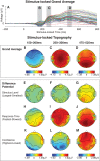Frontal scalp potentials foretell perceptual choice confidence
- PMID: 32208896
- PMCID: PMC7191527
- DOI: 10.1152/jn.00290.2019
Frontal scalp potentials foretell perceptual choice confidence
Abstract
When making decisions, people naturally ask two implicit questions: how soon can I make a decision, and how certain am I? In perception, people's confidence (how certain?) shows a nonmonotonic relationship with response time (how soon?), such that choice confidence can either increase or decrease with response time. Although a frontoparietal network has been implicated as a neural substrate that binds choice confidence and action (e.g., response time), the dynamic interplay between choice behaviors within such a network has not been clarified. Here, we show that frontal event-related potentials (ERPs) reflect choice confidence before a decision. Specifically, we report a second positive peak of the stimulus-locked frontal ERP at ~500 ms that scales with confidence but not stimulus level, whereas the centroparietal ERP amplitude covaries inversely with response time. This frontal ERP component occurs before the response, which helps explain the inverse relationship between choice confidence and response time (i.e., higher confidence for shorter response time) when choice accuracy is emphasized over speed. Our findings provide the first early neural representation of confidence, consistent with the temporal precedence for its causal role in the current decision-making task: "I decided earlier because I am confident."NEW & NOTEWORTHY We report novel neural correlates of predecisional choice confidence in frontal scalp potential in humans. In conjunction with the centroparietal choice-action event-related potential component, this new frontal choice confidence component further elucidates the dynamics of the frontoparietal decision-making neural circuitry.
Keywords: ERP; SVV; choice confidence; decision-making; perception.
Conflict of interest statement
No conflicts of interest, financial or otherwise, are declared by the authors.
Figures








Similar articles
-
Connectivity and local activity within the fronto-posterior brain network in schizophrenia.Suppl Clin Neurophysiol. 2013;62:181-96. doi: 10.1016/b978-0-7020-5307-8.00012-0. Suppl Clin Neurophysiol. 2013. PMID: 24053040
-
The free choice whether or not to respond after stimulus presentation.Hum Brain Mapp. 2009 Sep;30(9):2971-85. doi: 10.1002/hbm.20722. Hum Brain Mapp. 2009. PMID: 19172643 Free PMC article.
-
The late positive event-related potential component is time locked to the decision in recognition memory tasks.Cortex. 2024 Jul;176:194-208. doi: 10.1016/j.cortex.2024.04.017. Epub 2024 May 21. Cortex. 2024. PMID: 38796921
-
An early parietal ERP component of the frontoparietal system: EDAN not = N2pc.Brain Res. 2010 Mar 4;1317:203-10. doi: 10.1016/j.brainres.2009.12.090. Epub 2010 Jan 6. Brain Res. 2010. PMID: 20059986 Review.
-
Event-related potentials and recognition memory.Trends Cogn Sci. 2007 Jun;11(6):251-7. doi: 10.1016/j.tics.2007.04.004. Epub 2007 May 3. Trends Cogn Sci. 2007. PMID: 17481940 Review.
Cited by
-
Analog Resonance Computation: A New Model for Human Cognition.Front Psychol. 2020 Sep 9;11:2080. doi: 10.3389/fpsyg.2020.02080. eCollection 2020. Front Psychol. 2020. PMID: 33013530 Free PMC article.
-
Pharmacological Elevation of Catecholamine Levels Improves Perceptual Decisions, But Not Metacognitive Insight.eNeuro. 2024 Jul 29;11(7):ENEURO.0019-24.2024. doi: 10.1523/ENEURO.0019-24.2024. Print 2024 Jul. eNeuro. 2024. PMID: 39029953 Free PMC article.
-
Neural signatures of arbitration between Pavlovian and instrumental action selection.PLoS Comput Biol. 2021 Feb 10;17(2):e1008553. doi: 10.1371/journal.pcbi.1008553. eCollection 2021 Feb. PLoS Comput Biol. 2021. PMID: 33566831 Free PMC article.
References
Publication types
MeSH terms
Grants and funding
LinkOut - more resources
Full Text Sources

